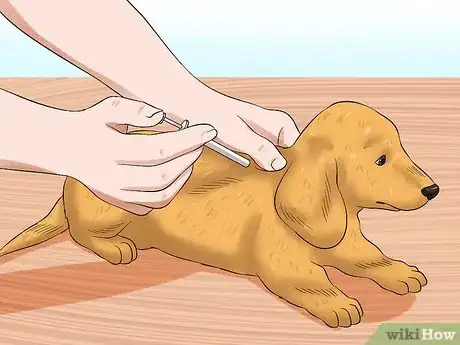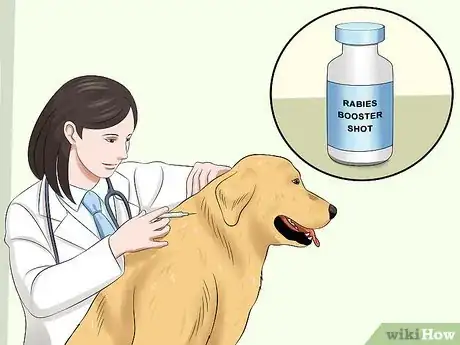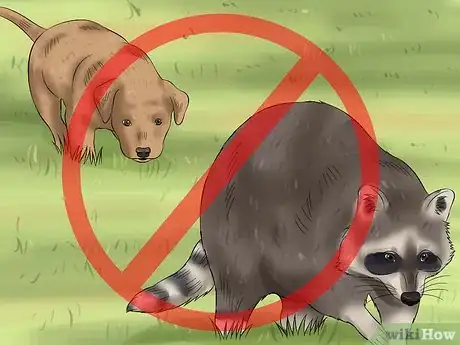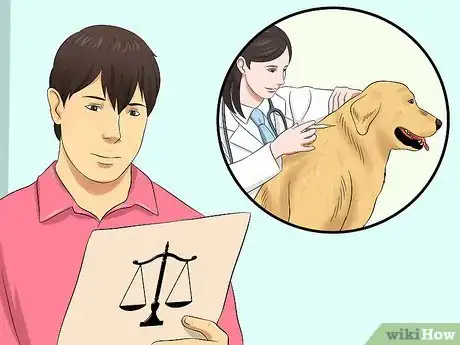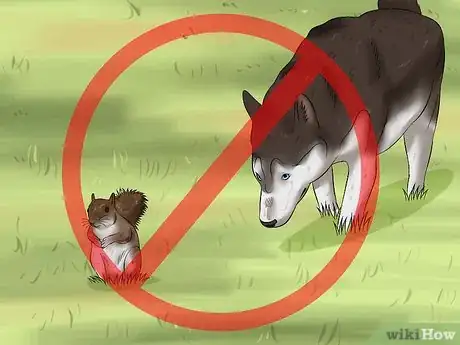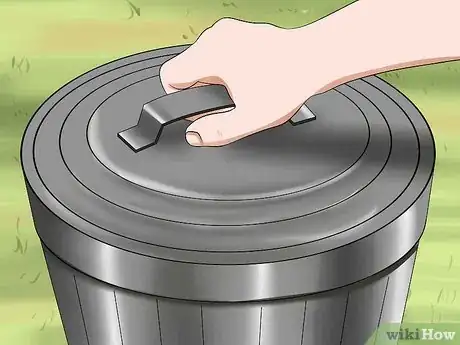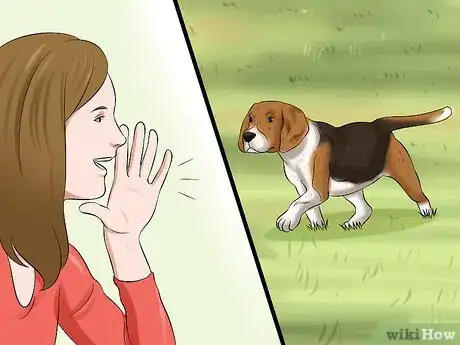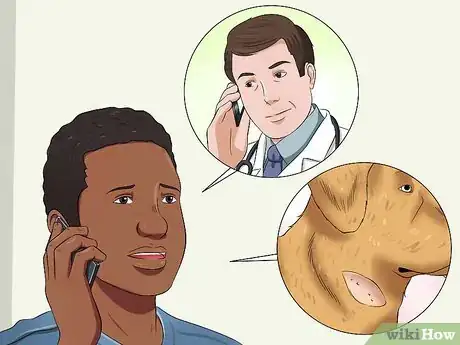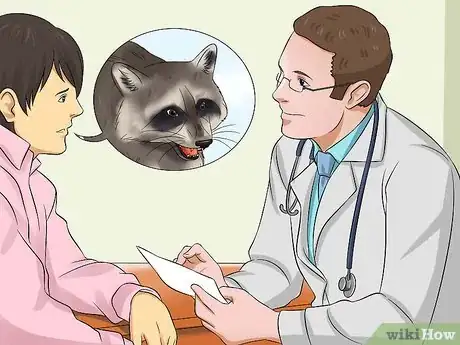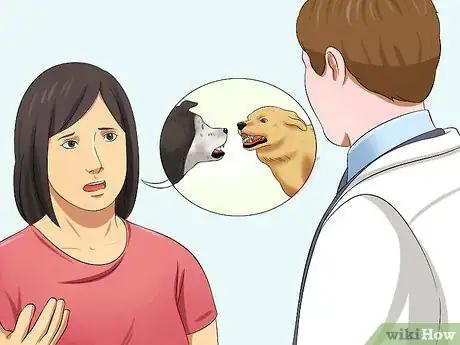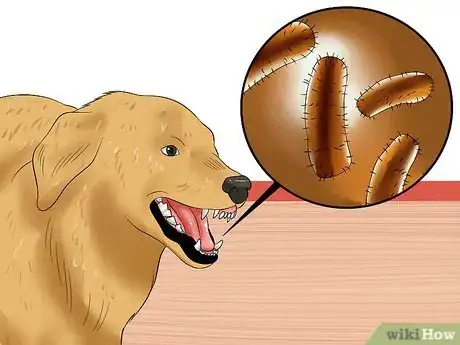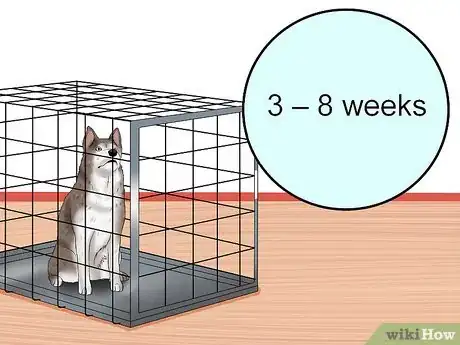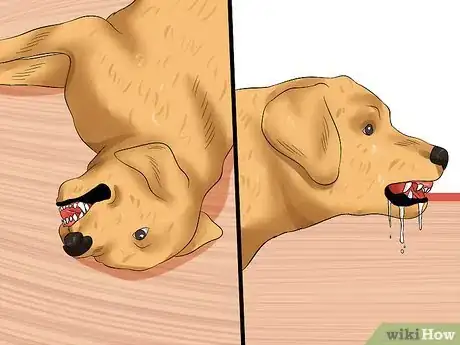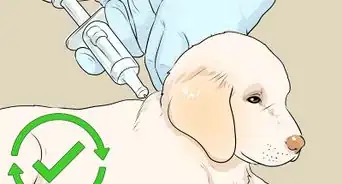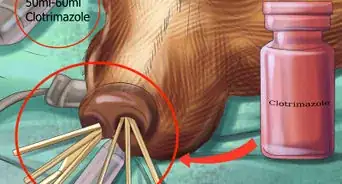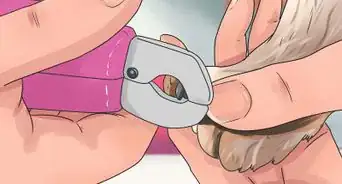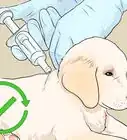This article was co-authored by Pippa Elliott, MRCVS. Dr. Elliott, BVMS, MRCVS is a veterinarian with over 30 years of experience in veterinary surgery and companion animal practice. She graduated from the University of Glasgow in 1987 with a degree in veterinary medicine and surgery. She has worked at the same animal clinic in her hometown for over 20 years.
There are 10 references cited in this article, which can be found at the bottom of the page.
This article has been viewed 16,247 times.
Each year in the United States, there are roughly 400-500 cases of rabies in domestic pets. This disease is caused by a virus that is transmitted when an infected animal bites another animal. Once infected, there is no cure and the condition is invariably fatal. This means prevention of infection is crucial to saving lives.[1] Preventing rabies requires a combination of regular vaccinations, reducing risk factors, and isolating animals that are at possible risk of incubating infection, so that they cannot go on to spread the infection.
Steps
Getting the Rabies Vaccination
-
1Have your dog vaccinated. The first vaccine is given to puppies from 12 weeks of age.[2] Check with your veterinarian about when your puppy is ready to be vaccinated.
- If you have found a dog or adopted a dog whose history you don't know, be sure to get it vaccinated.
- Once your dog is vaccinated, you should get a certificate that it has been done for your records.
- Stray dogs are especially at risk of getting rabies, as they have not been vaccinated. That is why limiting the stray pet population by spaying and neutering is an important part of preventing rabies in general.[3]
-
2Get your dog regular booster shots.[4] To maintain protection, the first booster is given when the dog is one-year old and then every three-years thereafter for the remainder of the dog's life. This helps protect the dog from infection should it be bitten by an animal, such as infected wildlife or another dog.
- It also makes it unlikely that the dog could transfer infection to a person should the dog bite someone.
Advertisement -
3Keep young, unvaccinated puppies away from wildlife. Young puppies that are not old enough to be vaccinated can be susceptible to rabies infection.[5] While those puppies that are birthed from mothers that are vaccinated should have some immunities passed on from the mother, if the mother's immunity status is unknown, the puppy could be infected by contact with infected wildlife.
-
4Remember that vaccination is required by law in most cases. Most states have their own law about whether rabies vaccination is a legal requirement for pet cats and dogs.[6] It is best to check your state law to confirm the rules as they apply in your region.
Reducing the Risk from Wildlife
-
1Keep your dog away from wild animals. Wild animals can carry rabies, so be cautious about letting your dog near them. Supervise your pets outdoors and don't let them roam too far away from your eyesight.
- Discourage your dog from interacting with unknown animals, domestic and wild.[7]
-
2Discourage wild animals from visiting your yard.[8] Many people simply let their dogs out into their yards to go to the bathroom or to exercise. This is a time when your dog can come into contact with wild animals, if the wild animals have wandered into your yard.
- To deter wild animals, make sure trashcans are secure. This will assure that food does not attract them in. Clear rubbish and fallen leaves that could act as cover for wildlife. You can also plant plants that wild animals don't like the smell of or use commercial products that keep wild animals away.[9]
- In addition, don't feed your pets outdoors. Leftover food could attract wild animals.
-
3Make sure your dog will come when called. If you insist on letting your dog off leash at times, you should at least be sure that it will come immediately when called. This will allow you to stop it from interacting with any wild animals it comes across. Train your dog to have a strong recall so that you can call it out of trouble.
- Be wary of approaching animals you do not know or wildlife that is unusually docile, as this can be a sign of rabies infection. If your dog won't leave the animal alone, don't put yourself in danger as well by trying to physically intervene.
Getting a Dog Quarantined
-
1Contact your veterinarian if your unvaccinated dog is bitten by an unknown aggressor. If your dog is not vaccinated and is bitten by wildlife or a dog of unknown status who then runs off, then you must tell your veterinarian. It may be necessary to put the dog into quarantine for six months.[10]
- This is to separate your dog in case it caught infection off the stray and is incubating infection. In this case, it would therefore be a risk to other animals.
- Sadly, there is no blood test that can be done on a live animal that will confirm if it has an active infection or not. This means the only option is to wait and see if symptoms develop within a six month period. If the dog is still well at the end of this time, the infection is unlikely.
- This quarantine period may either be in a special state approved facility or within your own home, depending on individual state law.
-
2Notify your veterinarian if your unvaccinated dog is bitten by an unvaccinated dog you know or a wild animal that you caught. Catching the aggressor, whether wild or not, will allow your dog to go through a shorter quarantine period, usually 10 days. This is because the other animal can also be quarantined to check that it does not have rabies.[11] [12]
- The virus is only infectious when the animal starts to show signs of the disease. Since death occurs with five days of showing signs, if the biting animal is still healthy five days after the bite, then the animal it bit is not at risk.
-
3Report it to your veterinarian if your unvaccinated dog bites another dog or a person. If your dog is the aggressor and it is unvaccinated, or its vaccination status is unknown, then it needs to be quarantined. It may be put into a 10-day period of quarantine.[13]
- The 10 day quarantine guarantees that your dog has not infected the other dog. If your dog does not show signs of infection in 5 days, it means that it could not have infected the other dog or human. The infected animal is only contagious within 5 days of showing the first signs of infection.
Identifying Rabies
-
1
-
2Understand the incubation period for rabies. Rabies has a long incubation period before the animal shows signs, however once symptoms develop it is usually fatal within 5 days.[16] How long the incubation period is depends on how far away from the brain the bite was.
- The virus travels from the bite to the brain via nerves, so the greater the distance, the longer it takes for signs to show up. The strength of the host's immune system can also determine how long the incubation period is.[17] Those animals in poor health with weak immune systems will succumb more quickly that fit animals.
- An average incubation period is on average three to eight weeks. However, in exceptional cases it can be as short as nine days and as long as several years.
-
3Be aware of the symptoms of rabies. During the incubation period the animal shows no signs. Once the virus reaches the brain, the first symptom is often behavioral changes. This could be a change in the dog's character from loving to aggressive, or the other way around. Many dogs appear extremely anxious or, conversely, can be much more friendly than usual.[18]
- The next stage is the dog becomes over sensitive to light and sound. It may have seizures and it may also become dangerously aggressive.[19]
- Then in the final stages of the disease, the dog develops paralysis of the head and neck muscles and is unable to swallow. This leads to drooling saliva that it has produced but cannot swallow.
- Death is from paralysis of the respiratory muscles.
References
- ↑ https://www.americanhumane.org/fact-sheet/rabies-facts-prevention-tips/
- ↑ https://www.americanhumane.org/fact-sheet/rabies-facts-prevention-tips/
- ↑ http://citeseerx.ist.psu.edu/viewdoc/download?doi=10.1.1.391.4724&rep=rep1&type=pdf
- ↑ http://pets.webmd.com/pet-vaccines-schedules-cats-dogs?page=2
- ↑ http://www.ncbi.nlm.nih.gov/pmc/articles/PMC1950115/
- ↑ https://www.avma.org/Advocacy/StateAndLocal/Pages/rabies-vaccination.aspx
- ↑ https://www.americanhumane.org/fact-sheet/rabies-facts-prevention-tips/
- ↑ http://www.cdc.gov/rabies/prevention/animals.html
- ↑ http://npic.orst.edu/pest/wildyard.html
- ↑ https://www.americanhumane.org/fact-sheet/rabies-facts-prevention-tips/
- ↑ https://www.americanhumane.org/fact-sheet/rabies-facts-prevention-tips/
- ↑ http://pets.webmd.com/dogs/rabies-dogs?page=2
- ↑ https://www.americanhumane.org/fact-sheet/rabies-facts-prevention-tips/
- ↑ https://www.publichealthmdc.com/environmental/animal/rabies.cfm
- ↑ https://vetmed.tamu.edu/news/pet-talk/rabies-prevention
- ↑ https://www.americanhumane.org/fact-sheet/rabies-facts-prevention-tips/
- ↑ https://www.americanhumane.org/fact-sheet/rabies-facts-prevention-tips/
- ↑ https://www.publichealthmdc.com/environmental/animal/rabies.cfm
- ↑ http://www.cdc.gov/rabies/prevention/animals.html
About This Article
To prevent rabies in dogs, it's important that you get your dog vaccinated by a vet. Generally, dogs are vaccinated against rabies starting at 12 weeks and then given a booster shot at 1 year. After that, they should be vaccinated every 3 years for the rest of their lives. However, even if you didn't have your dog vaccinated when it was a puppy, or if you adopted an older dog, you should still get it vaccinated to protect it from rabies. In addition to getting your dog vaccinated, keep it away from wild animals since they can carry the virus. For advice from our Veterinarian co-author, like how to identify rabies in dogs, scroll down.
